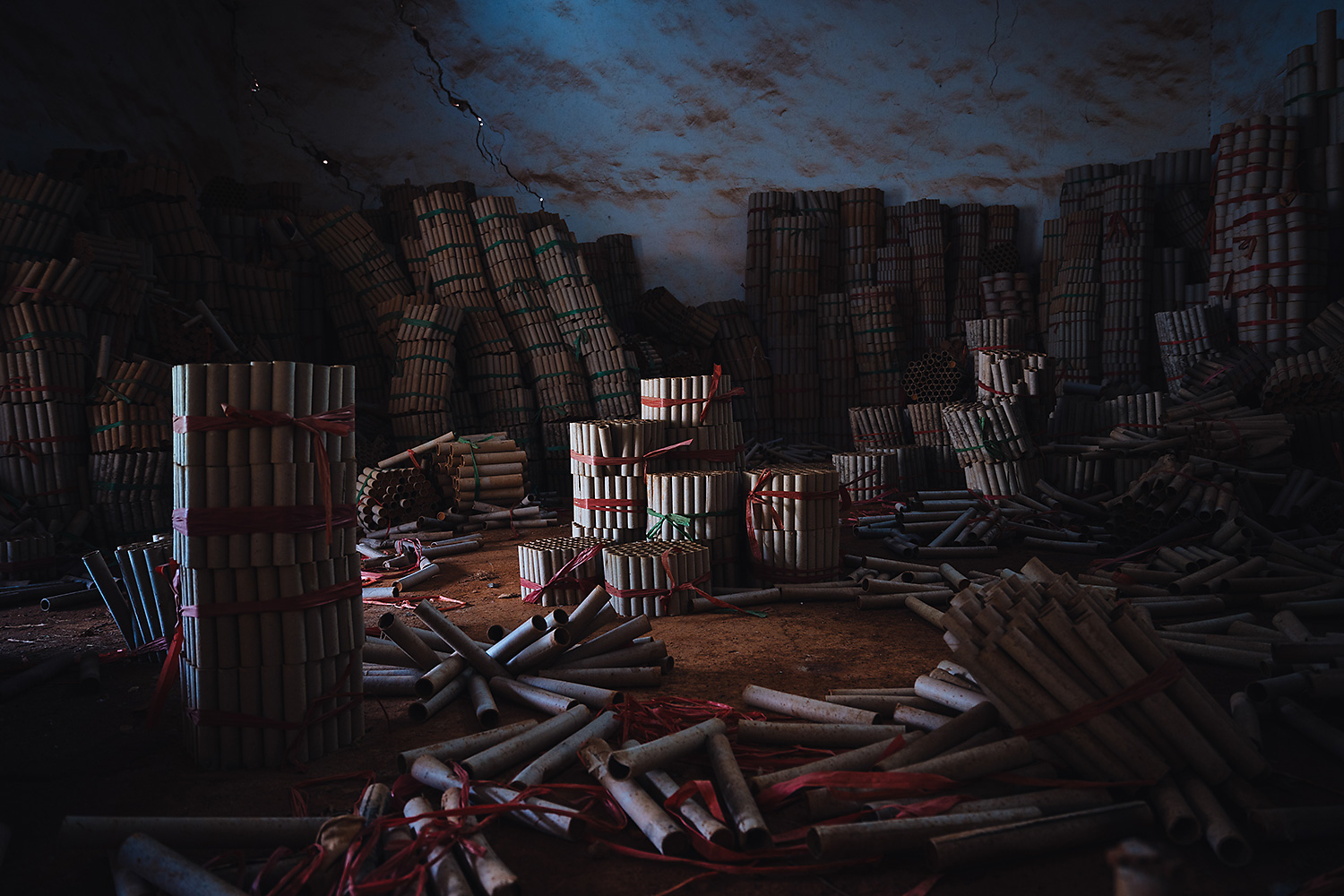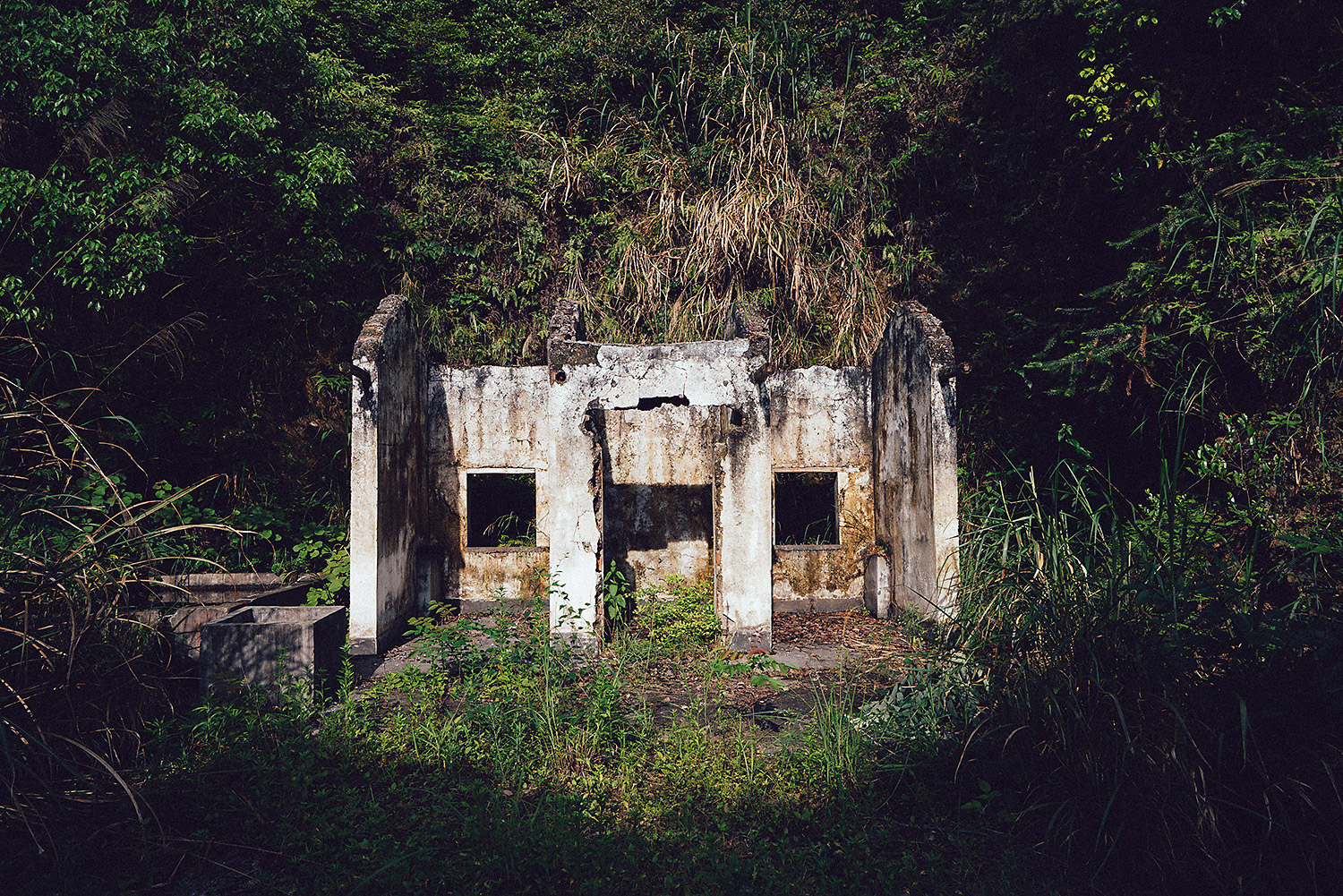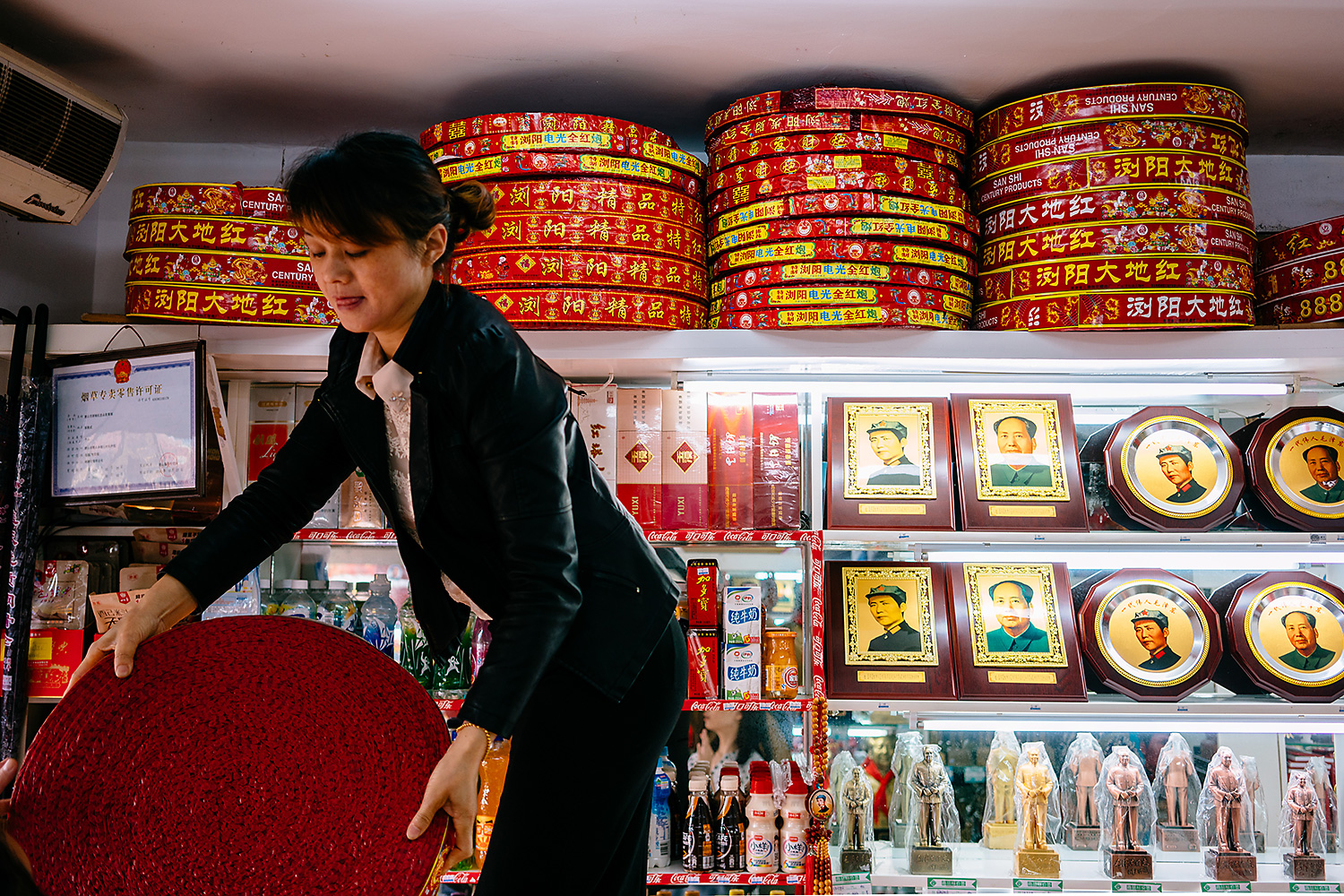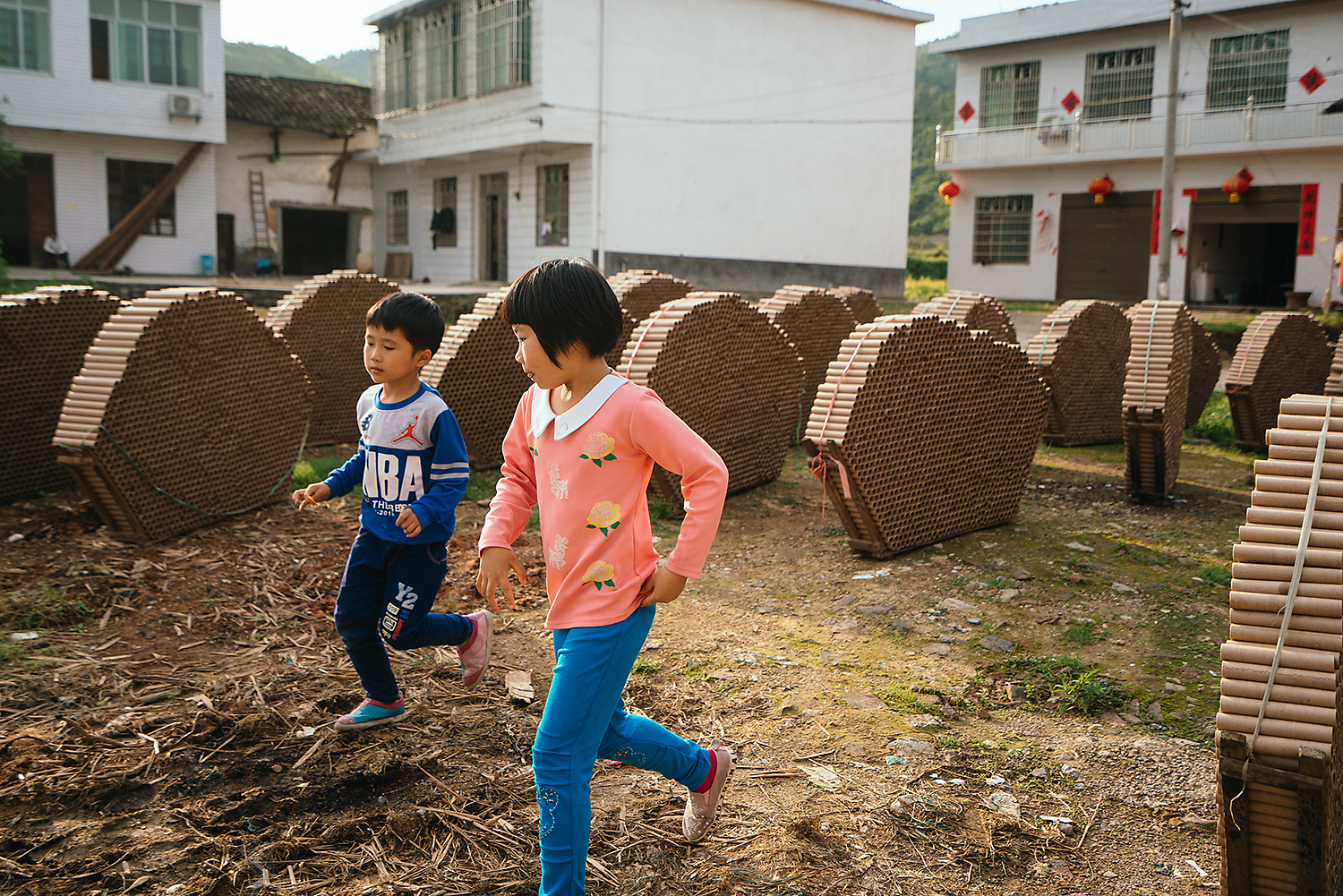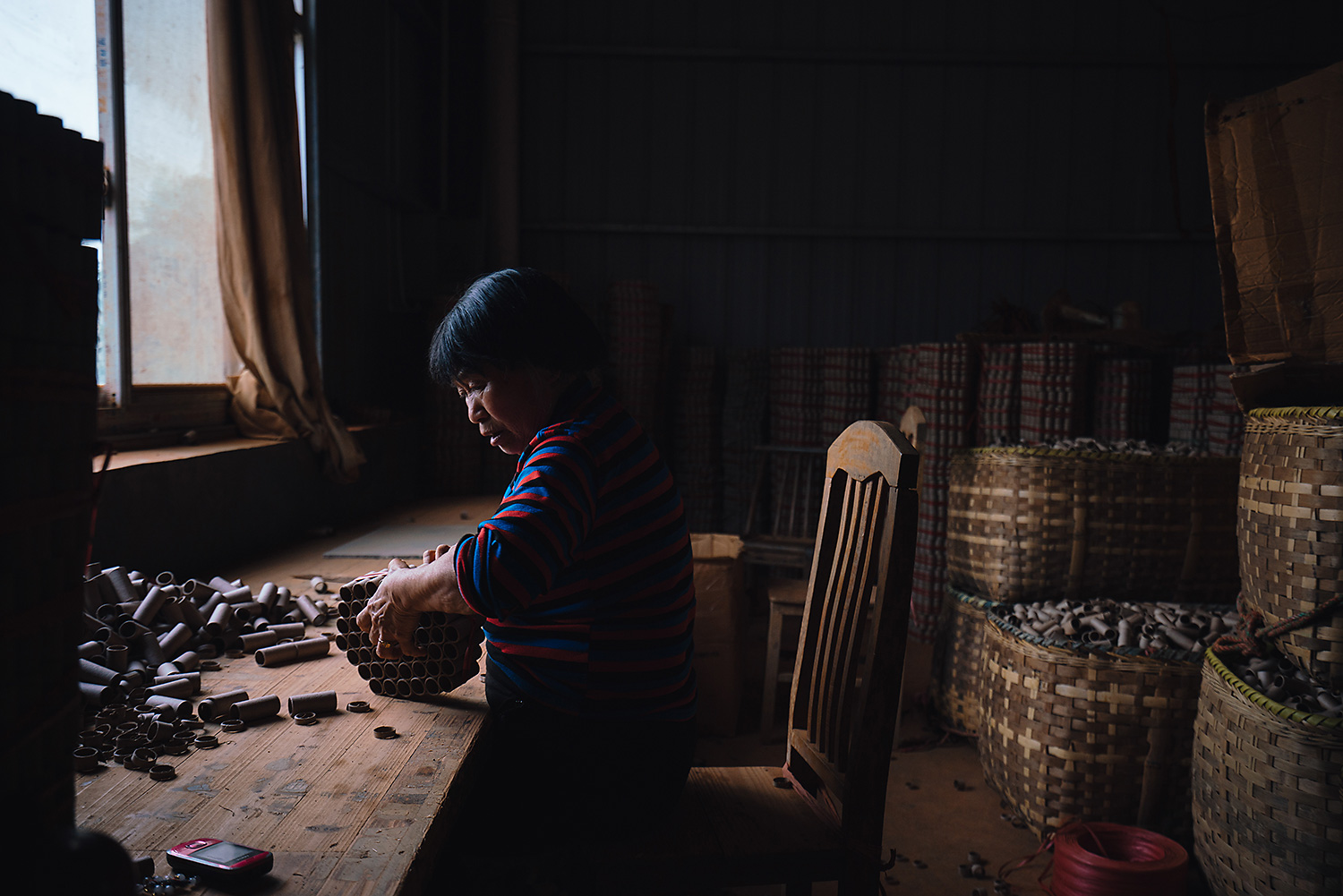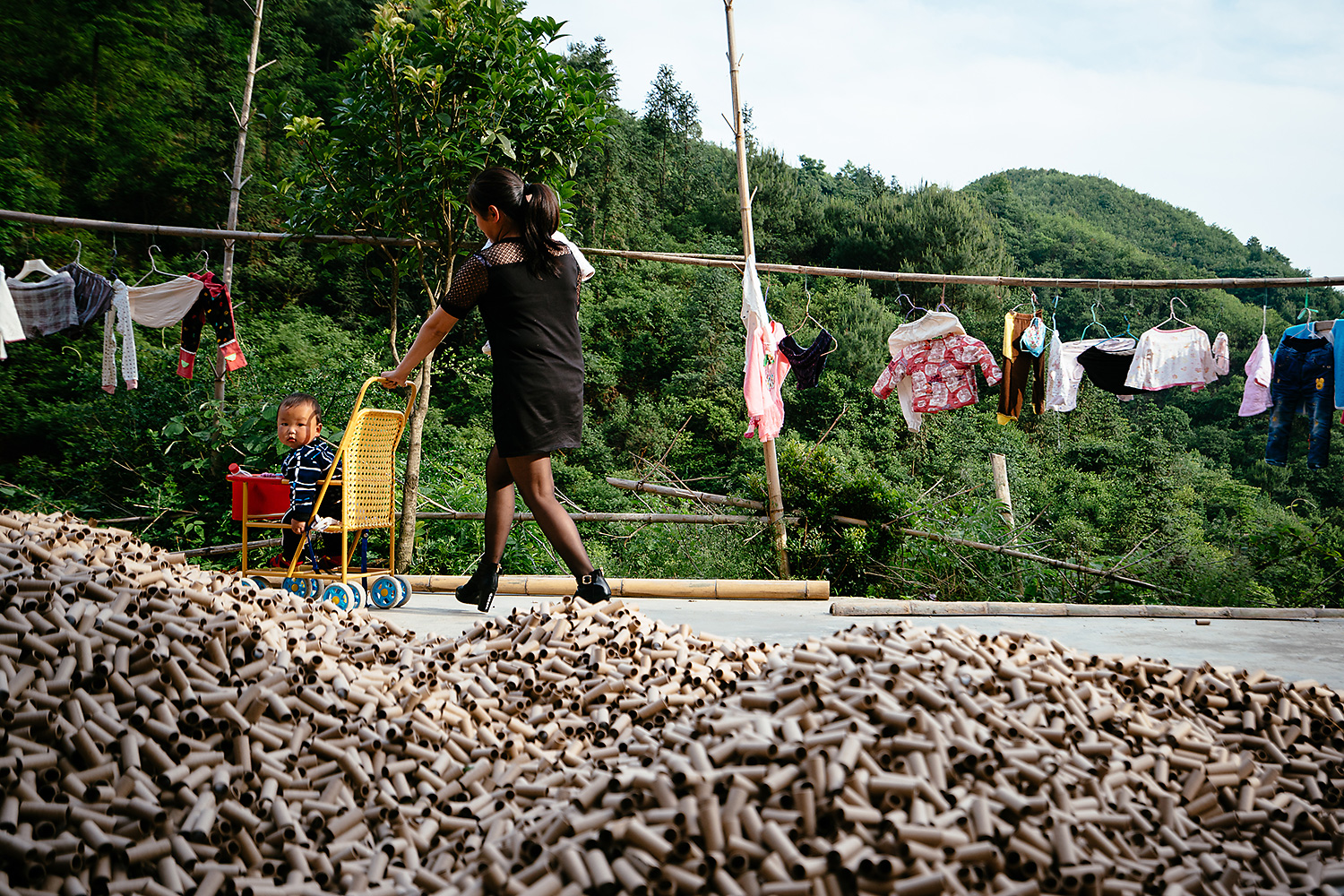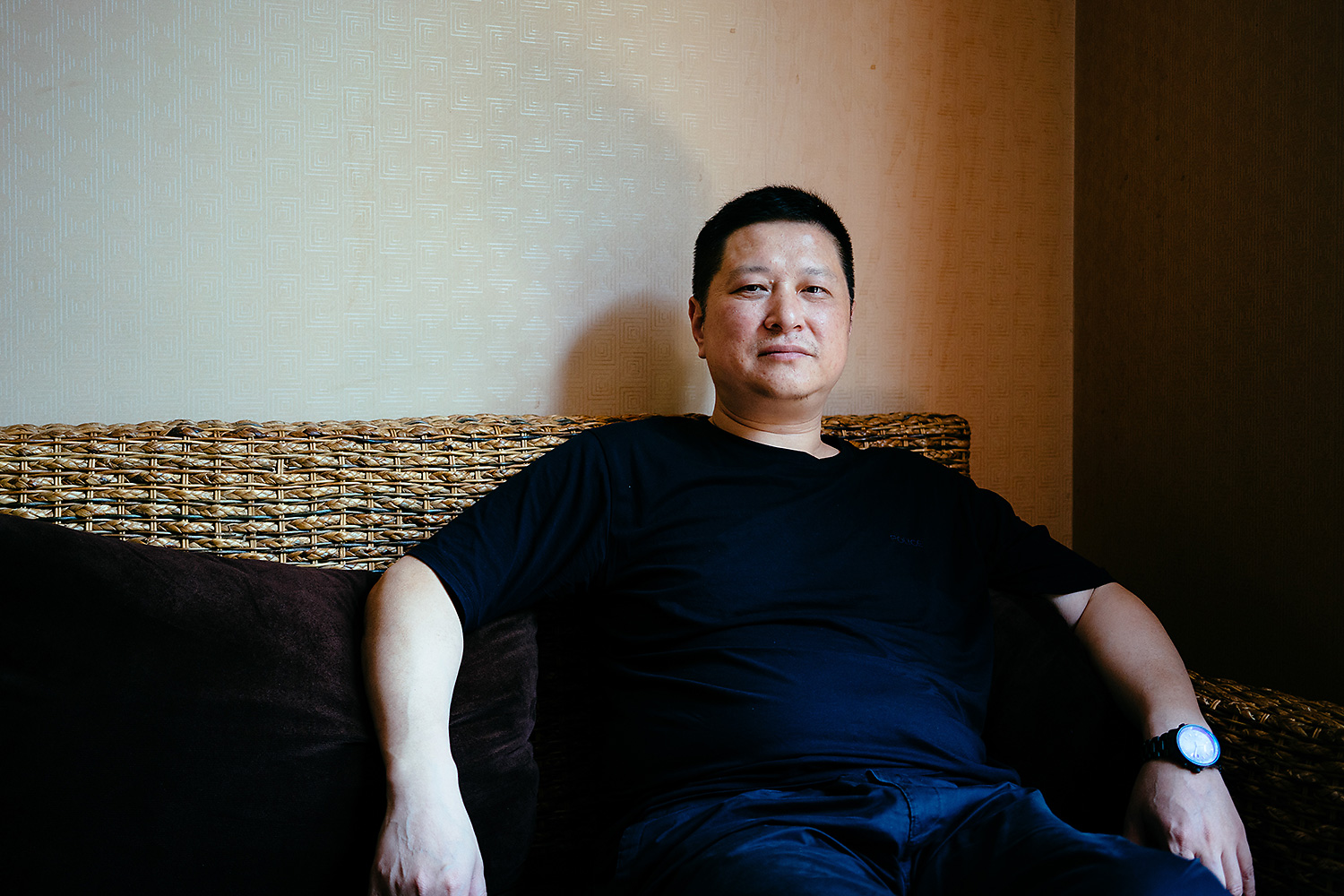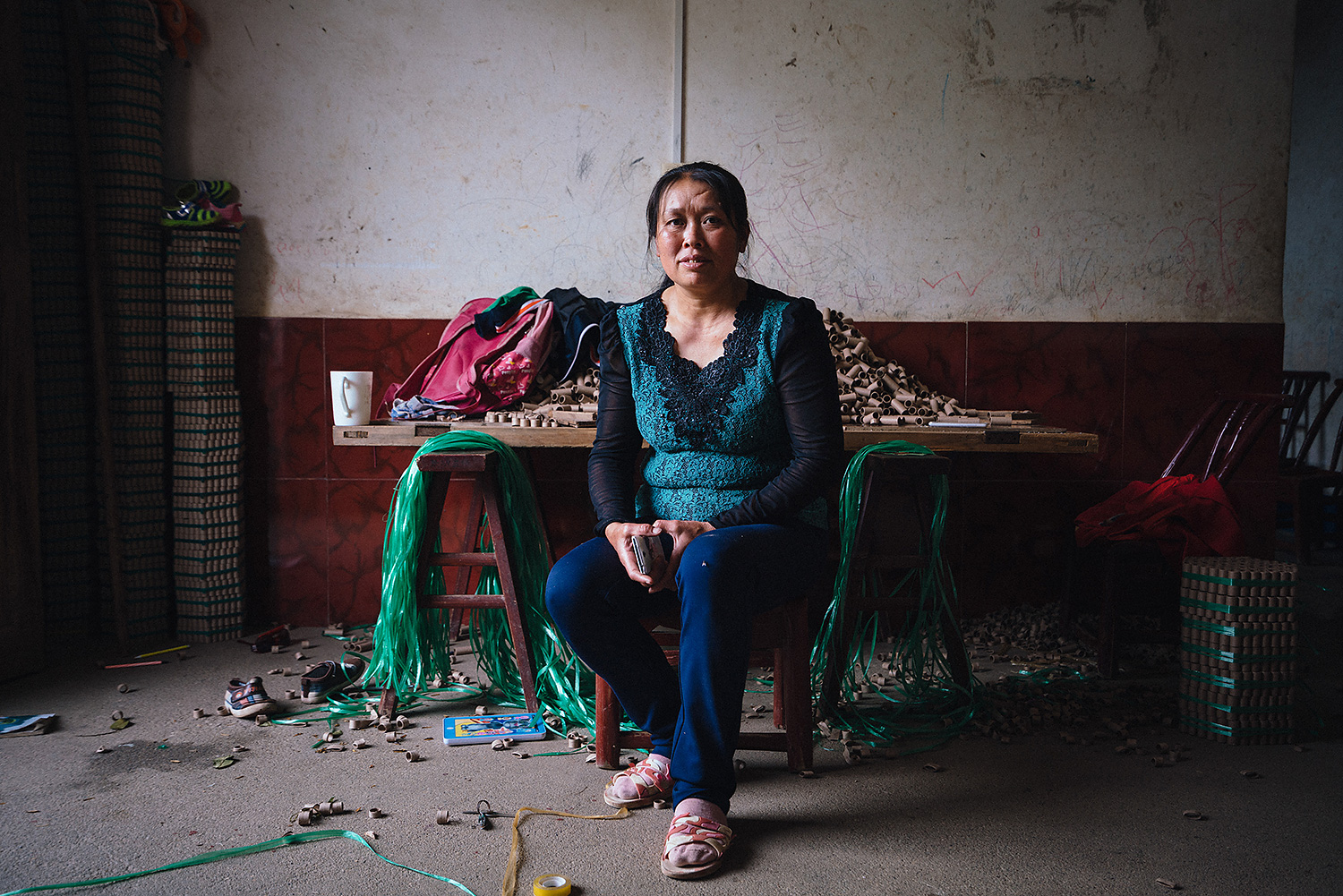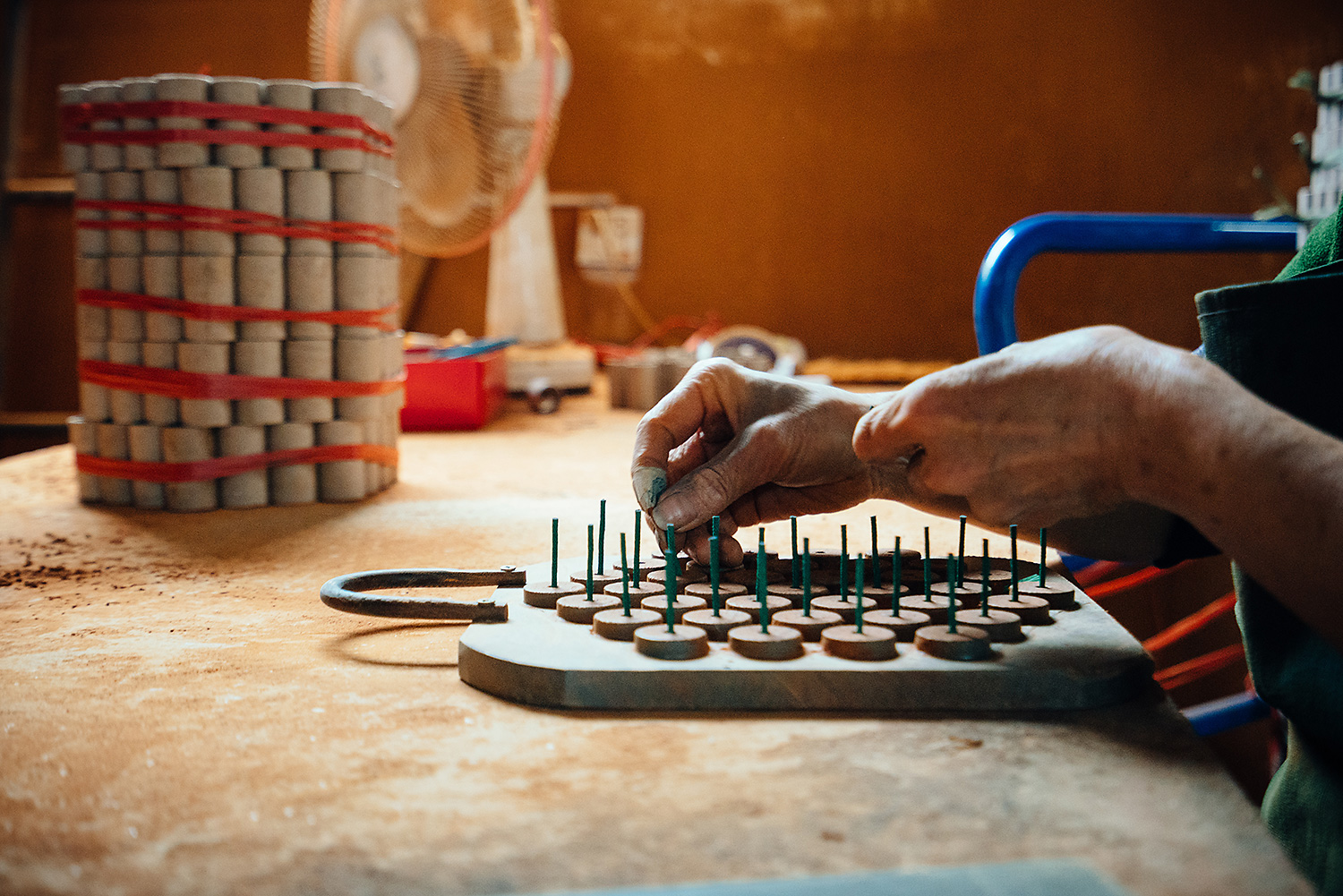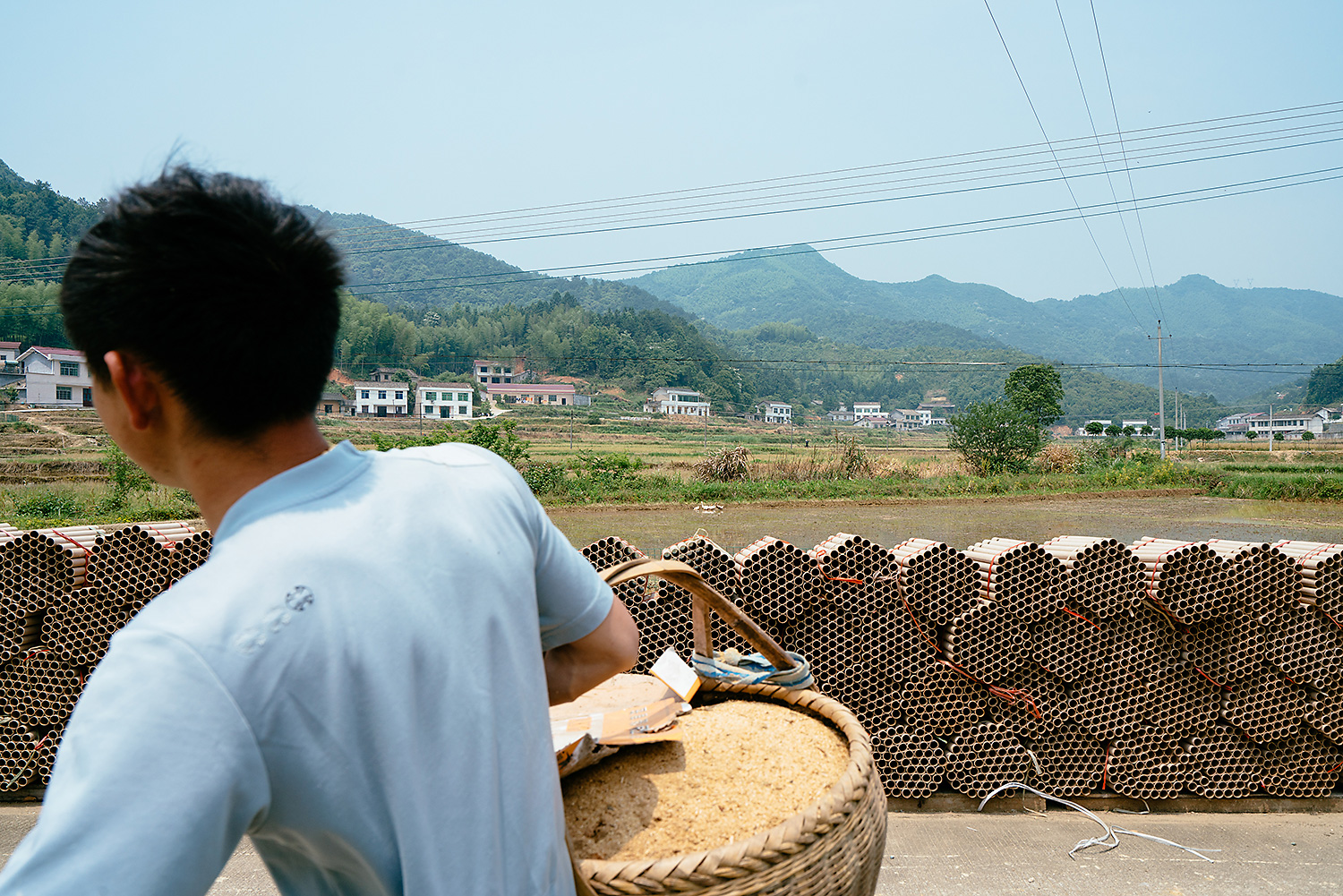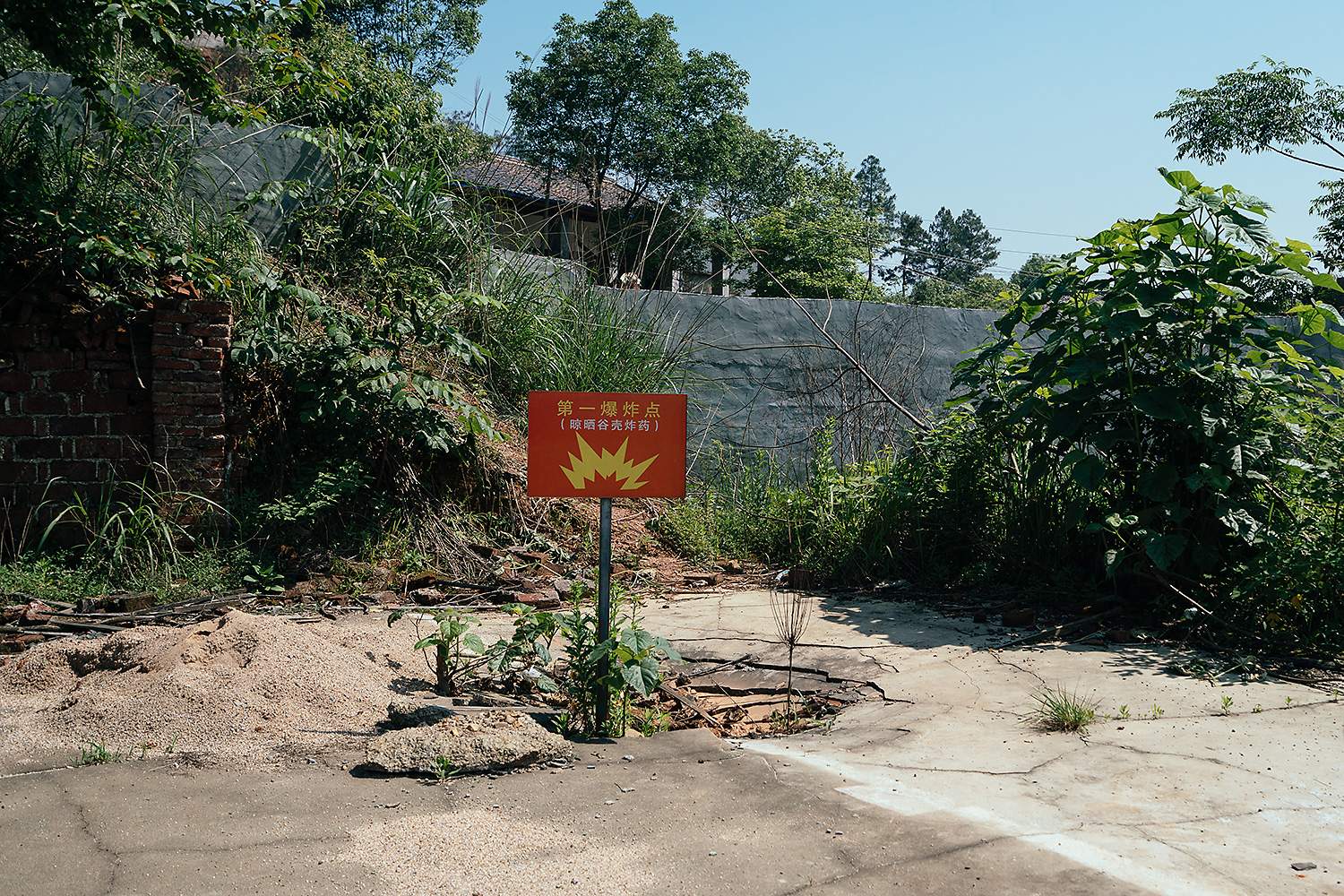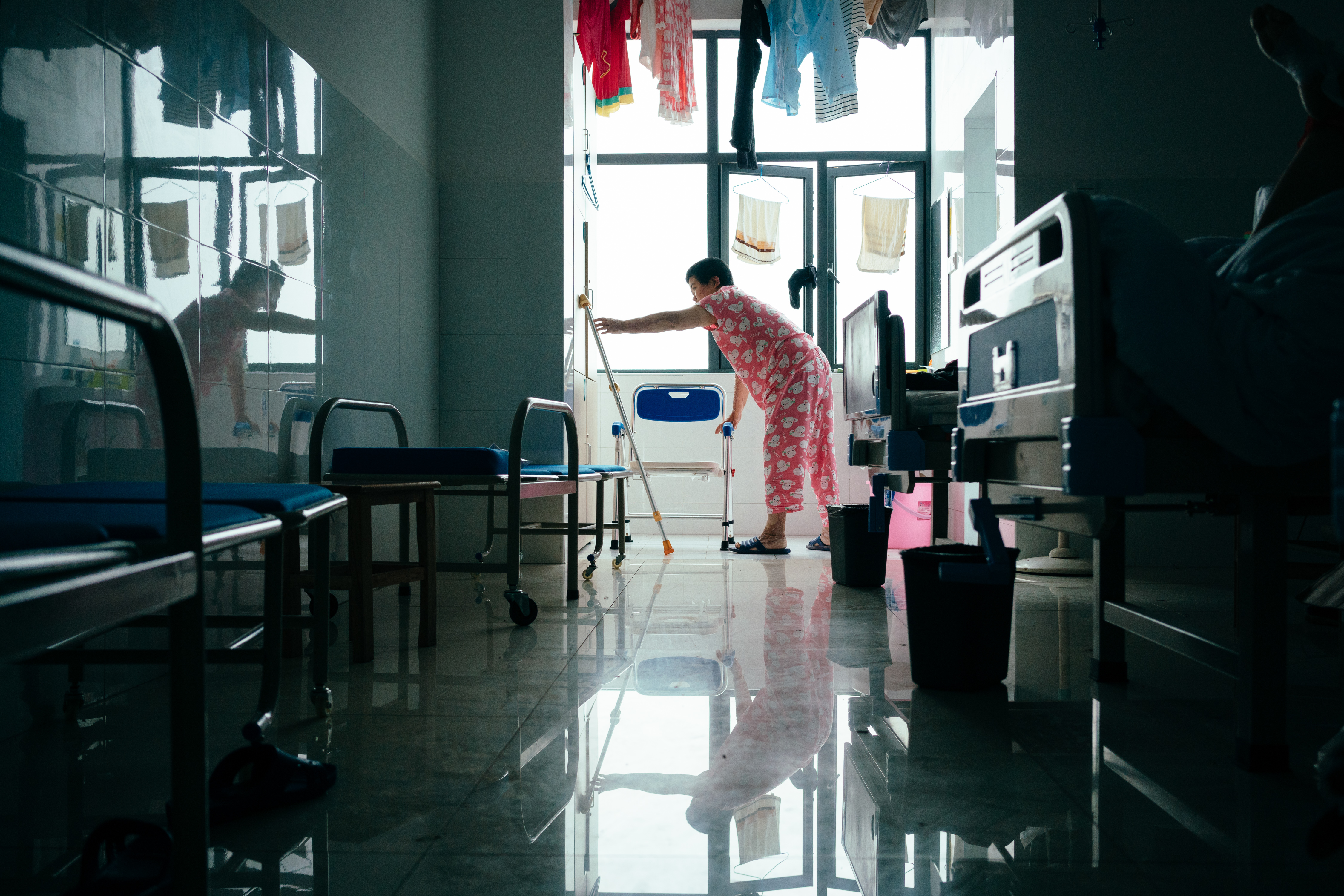On September 22, 2014, Huang Mingwei fed her two-year-old daughter, put on a peach-colored dress dotted with yellow flowers—her husband’s favorite—and cycled up the road to work.
It was a muggy first day of fall, a morning with nothing in particular to distinguish it from the decade of Mondays Huang had toiled at the Nanyang Export Fireworks Factory in southern China’s Hunan province. By that afternoon, 14 women—her co-workers—lay dead or dying in the rubble of the exploded factory, and Huang would begin a year-and-a-half-long hospital stay to treat severe burns covering 70 percent of her body. Of the 47 people working in the factory that day, only three escaped with no injuries. The rest became casualties of one of China’s most dangerous and ignored industries: the manufacture of the world’s fireworks.
In recent interviews, Huang, now 29, and other former Nanyang factory workers described the workday that nearly killed them and left their lives irreparably damaged.
Huang was in a packing warehouse when, at 3 p.m., someone in the building next-door triggered an explosion by sweeping rice hulls off the floor. The hulls, highly combustible materials used to burst the cardboard shell of a firework and heave its colored stars into the air, are a key ingredient in making fireworks. Chinese safety regulations dictate careful disposal of leftover hulls, but that day they were swept away like harmless debris, the casual meeting of friction with flammables setting off the catastrophe.
A fire engulfed the first building, then ignited a rolling series of explosions that swept through the too-close-set red brick shops like wind. Huang was knocked down by the first blast, got back to her feet, and ran outside, joining a rush of co-workers scrambling toward the hillside behind the factory. As the fire gathered fuel, flames shot skyward, sending shattered glass and bricks hundreds of feet. Building by building, the factory crumpled.
“I had barely run out of the workshop before I fell,” Huang says. “A loud explosion went off near my ear and I lost consciousness.” She awoke some time later, with no memory of how she had moved 10 feet. “The ground was littered with bricks and one of my feet was buried. There were several co-workers at the foot of the mountain and in the other direction was all fire.”
In the village, Huang’s husband, Deng Lei, heard the explosions and joined the dozens of men in Baofeng who ran toward the blast, frantically looking for their wives, mothers, aunts, and sisters.
China’s fireworks factories, which produce an estimated 90 percent of the world’s fireworks, make up a perilous industry staffed mainly by rural women: Men typically work in the management offices while women, most of whom go straight to factory work out of high school, staff the lines. The industry developed in villages where men went outside of the village or often far away to work, either on farms or in factories, so women were hired to do the detail-oriented work of making the decorative explosives. They handle dangerous chemicals everyday with little prior training, and despite growing efforts by the Chinese authorities in recent years to make the industry safer, things frequently go wrong—often with lethal or life-changing consequences.
When things do go wrong, workers and their families are left with very little recourse. China’s worker-compensation law requires employers to pay into a fund reserved for injury and disability payments, but compensation is often tied up for years or not paid at all. At the same time, despite its many casualties, the industry has flown under the radar of most Chinese and international labor groups. And while the Nanyang workers were making products for foreign export, international law provides few protections. Consumer campaigns have had an impact naming and shaming companies with global brands to maintain, but fireworks brands are so unfamiliar to consumers that they provide little leverage for such campaigns. “That is why fireworks is a struggle,” says Richard Brubaker, a corporate accountability expert and founder of the Shanghai-based consulting firm Collective Responsibility. “The average U.S. consumer has no idea where they come from. There’s no brand around them they recognize.”
At Nanyang, the conditions were perfectly set for disaster. Safe fireworks production takes up a lot of room; workshops are supposed to be set widely apart, with exact spacing determined by the amount of explosive material in each building. Chinese law also limits the number of workers in each room that contains combustibles. However, buildings were crowded with too many people and too much flammable material in Nanyang. Police and safety investigators faulted chaotic management and the flouting of safety rules—specifically those limiting the amount of combustibles and number of workers in each space—for causing the catastrophe. They also cited overproduction, the most basic indicator of dangerous conditions, a sign that factories cut corners to get more products out faster.
“I saw people lying on the road and screaming because of the pain,” Huang’s husband, Deng Lei, says. “I attempted to rush in from the gate but the fire was as high as 6 meters.”
Forty minutes after the first explosion, Deng spotted his wife but nearly didn’t recognize her: She lay prone on her back, face up to the sky, her long black hair burned to a short frizz atop her scorched scalp. He ran toward the peach-and-yellow dress, now burned and melted to her skin in places, picked her up, and carried her away from the factory toward an ambulance.
“I couldn’t smell when I woke up, nor did I feel any pain,” Huang says. “It was a half an hour or so before I realized that I couldn’t bear the pain all over my body.”
For others in Baofeng village, which has fewer than 1,000 residents, the frantic race and search ended in heartbreak. The road leading into the factory was the subject of a land dispute and had been blocked by a brick wall, shutting out fire and rescue crews. Men in the village spoke about being shut out from the accident scene while trying to find their relatives. Many, like Deng Rujun, ran to find their wives only to finally get past the barricades and find it was too late. Some, like Xia Zhiwei’s mother, who was in her late 50s, were burned beyond recognition and could only be identified through DNA tests days later.
* * *
The bulk of China’s estimated U.S.$4 billion fireworks industry is centered in the southern Chinese province of Hunan in and around Liling, a mountainous rural county not far from the provincial capital of Changsha. China invented fireworks, and local lore has it that the Hunanese have been making them for centuries. Many of the factories in and around Liuyang and Liling claim to use formulas handed down through generations.
Today, a journey through the county’s villages and towns leaves the impression that everyone is involved in the fireworks industry in one way or another. Farmers amass side incomes by rolling and dyeing cardboard shell casings in their backyards and on kitchen tables while village women bring in tidy sums from factory line work. Roadways are lined with the brown and red cardboard casings, ready to be filled with explosive charges, packaged, and shipped across China and around the world to supply the globe’s holiday celebrations, from Lunar New Year in Asia to the Fourth of July in the United States. When many U.S. states relaxed consumer fireworks laws in the 1990s, demand ramped up and factories went into year-round production.
The factories themselves range from small operations making cheaper goods oriented toward Chinese markets to big operations like Nanyang, which could turn out five shipping containers of fireworks per week. The women there made high-demand consumer fireworks exported to the United States and elsewhere. Chinese television footage from after the explosion showed packaging among the debris bearing the label of Texas Outlaw, an American brand owned by a company called Red Rhino, which is in turn owned by an LLC, Crazy Debbie’s.
Until recently, local children were an active part of the fireworks industry. In 2001, a blast in eastern China’s Fanglin village killed 42 people, most of them third- and fourth-graders, required to put detonators into fireworks as part of a “work-study” program to prop up their underfunded school. Another blast followed in 2009, killing at least 12 primary-school children in a fireworks workshop in Guangxi.
Villagers across the fireworks production region know the work is dangerous, but it pays—$500 to $600 a month, on par with other industries and a decent salary in Hunan—enough to allow them to stay in their hometowns rather than moving hundreds of miles away to work in southern China’s lonely factory cities. And despite the known dangers and accidents, Hunan’s residents delight in setting off and watching fireworks displays. Every summer Saturday night in Changsha, thousands of the city’s residents gather along the banks of the Xiangjiang River to watch a pyrotechnics display that would rival any July 4 celebration in the United States.
For decades, China’s fireworks industry has been plagued by deadly accidents. By 2009, the government began scaling back production and ramping up safety checks in Hunan and surrounding areas. But as late as 2014, the same year as the Nanyang explosion, Wang Haoshui, Chief Engineer with China’s State Administration of Workplace Safety, told a Chinese newspaper that fireworks continued to be the country’s second-most dangerous industry, right behind coal mining. Between 1986 and 2005, an average of 400 people were killed every year making fireworks in China, according to official data published in Chinese media. But coal mines, where 931 workers were killed in 2014 according to Chinese government data, get far more attention.
For the hundreds who have been injured or killed in China’s fireworks manufacturing over the years, there is little recourse. The central government sets a standard for workplace accident compensation—a one-time payout of 20 times the national average annual urban income for those killed on the job—but according to labor monitors, it is rarely followed to the letter. The China Labour Bulletin, a Hong Kong-based rights monitoring group, refers to the system as “China’s compensation lottery,” charging that its implementation depends largely on how high-profile the deaths are and who is paying attention. Compensation is further hamstrung by the failure of companies to pay into the national insurance fund. Those who are injured, but not killed, face an uphill battle, stonewalled by local governments and unable to effectively access the courts.
Over eight days in May, we crisscrossed China’s fireworks manufacturing region in Hunan and Jiangxi, and spoke with more than two dozen workers and family members, along with villagers and lawyers tangentially involved in the trade. The picture that emerged was of an industry safer and better regulated than in years past but still rife with dangers and little support for injured or killed workers. More than one victim in Hunan asked us for help navigating the system—requesting that we accompany them to a local government office to demand injury compensation or connect them with lawyers. In rural regions like Hunan and Jiangxi, the law can seem out-of-reach to injured workers.
After the Nanyang explosion, families of the 14 dead women were paid 500,000 yuan (about U.S.$76,000) each, the precise number mandated by government rules. Survivors we spoke with had lifesaving medical expenses covered but nothing more. Huang and her surviving colleagues—some of whom are no longer able to work—say the government promised them some compensation, but nearly two years after the accident, they still have nothing to replace lost incomes and continued medical expenses.
In years past, a growing fleet of community lawyers and labor activists guided injured workers across China’s manufacturing and extraction industries, from electronics to coal, through the compensation and court claims process. That activism has not reached fireworks factories: an industry with low profit margins, staffed by village women, and located far from China’s traditional factory zones. With a recent government crackdown on labor groups and rights lawyers underway, the odds are now even lower that outside help will reach fireworks workers.
Nanyang’s workers are among an estimated 453 million people employed in the global supply chain, according to the International Labour Organization—constituting more than one in five jobs worldwide. Yet, according to Gregory Tzeutschler Regaignon of the Business & Human Rights Resource Centre, an advocacy and research group based in London and New York, “There’s no clear legal precedent that applies right now that says a company can be held liable for dangerous working conditions in the supply chain.”
As a result, worker injuries and deaths in global supply chains often fall into a legal gray zone, with multinationals and subcontractors alike frequently shrugging off blame and potential responsibilities. And while trafficked or forced workers have some recourse under the law, there are few global remedies in cases of workplace injury or death.
If any Nanyang workers were to seek legal redress from U.S. companies that import the goods they make, they would come up against the limits of current global frameworks around business and human rights, which offer no binding enforcement or much in the way of adjudication. The United Nations developed a set of “Guiding Principles on Business and Human Rights” in 2011, which offer three broad guidelines about businesses’ responsibility for respecting human rights, and countries’ duties to protect people from corporate abuses and provide legal remedies to any victims. But the principles are not enshrined in an international treaty, nor do they set forth new legal obligations or enforcement mechanisms.
Another international framework under the Organization for Economic Co-operation and Development (OECD) allows workers and advocates to file complaints against corporations. But while complaints can result in mediation, companies can simply walk away from the table if don’t like the result—the decision is non-binding. As of 2015, only 1 percent of the 250 cases filed in a multitude of industries resulted in outcomes “that directly improved conditions for the victims of corporate misconduct,” according to an OECD Watch report.
Concrete improvements to supply-chain oversight have often come at the cost of many lives—as spectacular industrial accidents come with a reputational risk for multinationals. It took the 2013 collapse of the Rana Plaza complex in Bangladesh—which killed more than 1,100 workers making clothing for U.S. and E.U. companies including Benetton, Walmart, and JCPenney—to create the Accord on Fire and Building Safety in Bangladesh, a five-year legally binding agreement between trade unions and more than 200 clothing and footwear companies to improve factory and fire safety in the garment industry there. But that groundbreaking accord expires in 2018. A case filed in Ontario, Canada, charges Canadian retailer Loblaws with negligence related to the Rana Plaza disaster, suggesting that the multinational is indirectly liable through its subcontractor New Wave. The suit also names French firm Bureau Veritas, which Loblaws had hired to conduct audits and inspections at Rana Plaza. The case could set precedent for holding companies responsible for what happens deep in their supply chains—including companies supplied by China’s fireworks industry.
In the absence of strong international oversight, some multinationals audit themselves or hire groups like Bureau Veritas as part of corporate social-responsibility efforts aimed at consumers. But some countries don’t require corporations to make these findings public.
In the United States, inspection of fireworks was, until recently, focused almost entirely on ensuring the safety of U.S. consumers. U.S. law prohibited the import of goods made by convict or forced labor, including forced child labor, but allowed companies to import goods made with such labor if domestic production of the goods couldn’t satisfy consumer demand. The “consumptive demand” loophole stood on the books for 86 years. During that time, the agency tasked with monitoring the issue, Customs and Border Protection (CBP), did not initiate any proactive investigations—responding only to complaints—and issued detention orders on imports only 30 times, most recently in 2000.
In March, Congress closed that loophole, effectively banning the importation of any goods made by forced labor, including forced child labor. This could increase scrutiny of the Chinese fireworks industry, which—in the wake of the 2001 and 2009 factory explosions in southern China in which children were among the dead, and allegations by a human rights group that a jail in Hunan had built a fireworks factory in 2006—earned a spot on the U.S. Department of Labor’s list of goods made by child or forced labor. In May, CBP Commissioner Gil Kerlikowske told a Senate committee that his agency plans to launch self-initiated investigations by drawing on the resources of 24 full-time staff assigned to investigate forced labor as well as nine foreign-government attachés funded by the State Department. It’s a daunting task: The U.S. imported more than U.S.$2.2 trillion in goods in 2015 alone.
Since closing the loophole, CBP has issued three detention orders—all for products allegedly made by Chinese prison labor. But Immigration and Customs Enforcement (ICE) officials must investigate each CBP allegation, and in order to do so, must receive permission from the government of the country in question. However, it usually takes China years to respond, according to Ken Kennedy, an ICE senior policy adviser on forced labor; when ICE agents finally receive Chinese clearance for a visit, he told NPR, the labor camps they’re investigating have sometimes vanished. Another catch with the new legislation: When a product is detained at a U.S. port, the importer has the option of simply re-exporting the goods to another country.
* * *
Terry Winkle, who owns Liuyang Flying Dragon Fireworks in Hunan province, has seen the insides of thousands of Chinese fireworks factories. After retiring from the U.S. Army two decades ago, Winkle opened a fireworks business in Minnesota. When he ordered a season’s worth of Roman candles from China—the cardboard cannons loaded with exploding colorful balls—and instead received a shipping container full of boring and hard-to-sell black snakes, he decided to move to China and learn the industry from the ground floor up.
That was 13 years ago. Now, Winkle’s company links buyers around the world with factories, and he’s selective about the manufacturers he connects to clients. Winkle checks out the factories himself; manufacturers let him in because he brings them business. He says safety violations, especially workshops crowded with too much material and too many workers, are red flags. Companies that flout safety regulations are accident-prone, which costs his clients money: When factories blow up, companies lose their deposits.
Winkle visited the Nanyang factory a few years ago—and walked away without placing an order. Winkle describes Nanyang as a “beautiful” factory that was nevertheless too crowded with materials and workers. “They looked good, they had tremendous production capability, but I knew it was an accident waiting to happen,” he said. “I thought, ‘If something happens, there’s a lot of people going down.’”
Winkle read the signs during a single visit, yet government safety inspectors allowed Nanyang’s factory to carry on with unsafe conditions until the 2014 explosion. Several former workers say the factory boss would get advance notice of inspections; whenever a review was scheduled, most employees were told to stay home for the day. So what inspectors likely saw was a bare-bones staff making very few products.
“Sometimes our boss would tell us to go home, saying investigators were coming in the afternoon,” says Huang. What she and other workers relate indicates a possible pattern of collusion between the factories and government inspectors, an allegation that emerged in later legal actions against government officials and the factory boss, according to Chinese press reports.
The American fireworks industry has its own system for inspecting firework products at the point of manufacture in China, but is generally hands-off when it comes to factory conditions. The vast majority of U.S. consumer-fireworks retailers and manufacturers are members of the American Fireworks Standards Laboratory (AFSL), an independent nonprofit corporation that assures compliance with safety regulations set by the U.S. Department of Transportation and the U.S. Consumer Product Safety Commission. For a little over three years, the AFSL offered some members an additional “social-responsibility” audit, which involved checking suppliers for child labor and forced labor. But in February, the AFSL suspended that program for re-evaluation.
AFSL consumer safety inspectors pull products from every lot that leaves every factory, but most of this testing takes place in storage warehouses far from manufacturing facilities. They do not perform factory audits or inspect the manufacturing areas, save in the case of some especially delicate products. “Part of our instruction to testers is try to avoid the manufacturing operation, typically for safety reasons,” says AFSL Executive Director John Rogers. “Once in shipping cartons, there’s much less risk of any kind of an incident or accident.”
One of AFSL’s consumer members is Crazy Debbie’s—parent company of Red Rhino, which now owns Texas Outlaw brand fireworks; it was the Texas Outlaw label that appeared on boxes in footage from after the Nanyang explosion. The Nanyang factory was on AFSL’s list of manufacturing sites visited by its inspectors. In fact, AFSL’s inspectors were at Nanyang the day of the explosion, according to Rogers. At the time, he says, AFSL had a contract with SGS, a third-party inspection, testing, and certification company, and SGS had sent out a two-person team that morning to test products. They left Nanyang without incident just hours before the explosion. AFSL now contracts with a different auditing company—Bureau Veritas, the same company named in the Canadian suit filed on behalf of Rana Plaza workers in Bangladesh. Neither Red Rhino nor SGS responded to requests for comment.
* * *
The Nanyang disaster may have been particularly embarrassing for Beijing: It came at exactly the moment China’s government was working to curb dangers in the industry and prompted a significant response from the central government, which forced local officials to clean house. The factory boss was sentenced to six years in prison for criminal negligence for violating safety regulations. Five local government officials were sacked for corruption and failing to uphold safety standards, and the provincial government banned all factories in Hunan for several months from making Nanyang’s core product, shells—those colored explosive balls that make up the guts of many fireworks.
When shell manufacturing resumed, very few factories were allowed to make them. Winkle estimates that 700 to 800 factories in the province were cut to fewer than 30. But orders keep pouring in, which could put pressure on these factories to stretch production unsafely beyond their limits.
In Nanyang, the local government turned the factory site into a large, public memorial, a rarity for factory accidents in China. Plaques at the entrance describe the “9.22” disaster and list the names of the 14 women who died. The ruined brick buildings, shattered glass, and burned paper casings were left in place, with markers showing each explosion site and each spot where a worker died. New grass and flowers have grown around the ruined buildings, but the ground still smells faintly of gunpowder in places.
For now, women like Huang and her surviving colleagues are trying to piece together their shattered lives. Most of the women are unable to work and face years of chronic pain.
“I haven’t earned a penny this year,” says Huang, who relayed her story in riveting detail while sitting at a table in her family’s kitchen. “I can’t stand for too long, or my feet feel a pain like the biting of ants. My body itches all over, but I don’t scratch now because you are here.”
Huang covers her ropey burn scars by wearing long sleeves and trousers when she leaves the house. Though one of her ears was singed, her face shows no damage from the fire. Others were not as fortunate.
The injured workers have tried to pool their complaints by drafting petitions and submitting compensation claims to the local government, but the petition process is arduous and frustrating. One Hunan woman recently traveled to Beijing to petition the central government over injuries she sustained years ago when she worked at a fireworks factory as a teenager.
The workers at Nanyang offer a stunning illustration of how the system fails its weakest. Those who survived the fire are left facing lifelong disfigurement, pain, and little hope of recouping their losses.
Nanyang worker Peng Jinhua, 30, is still hospitalized 20 months after the accident. She tells us she will be discharged soon because the local government has refused to pay for further treatment. Lying in her hospital bed, Peng breaks into tears while describing how she can’t afford plastic surgery to repair her missing right ear and the deep scars on her neck. She says a local government official told her these surgeries will not be covered—because they are not necessary to save her life.




